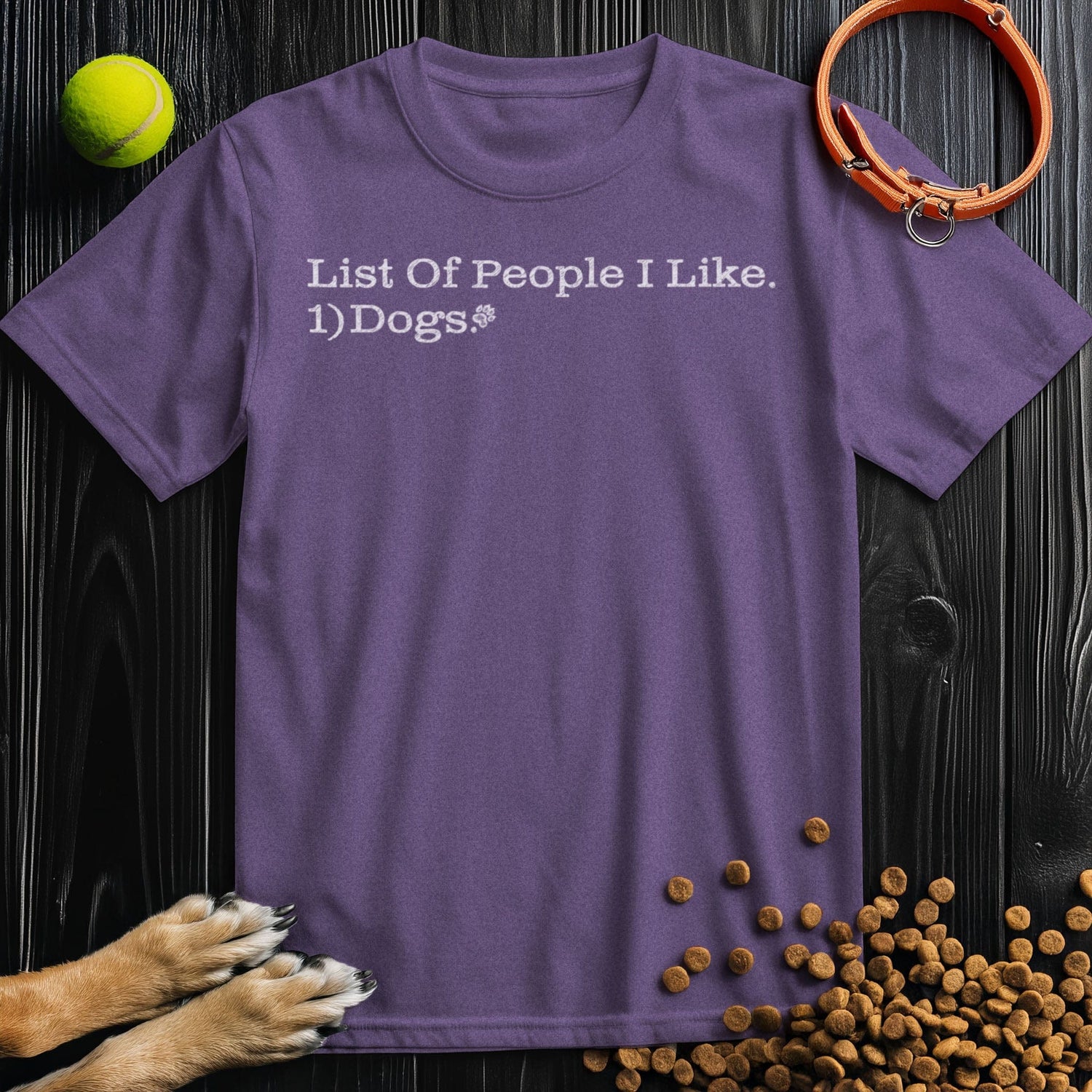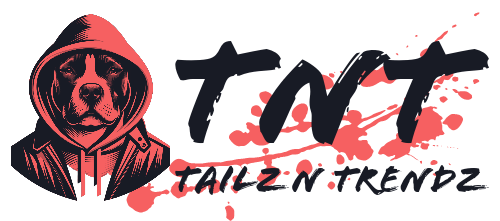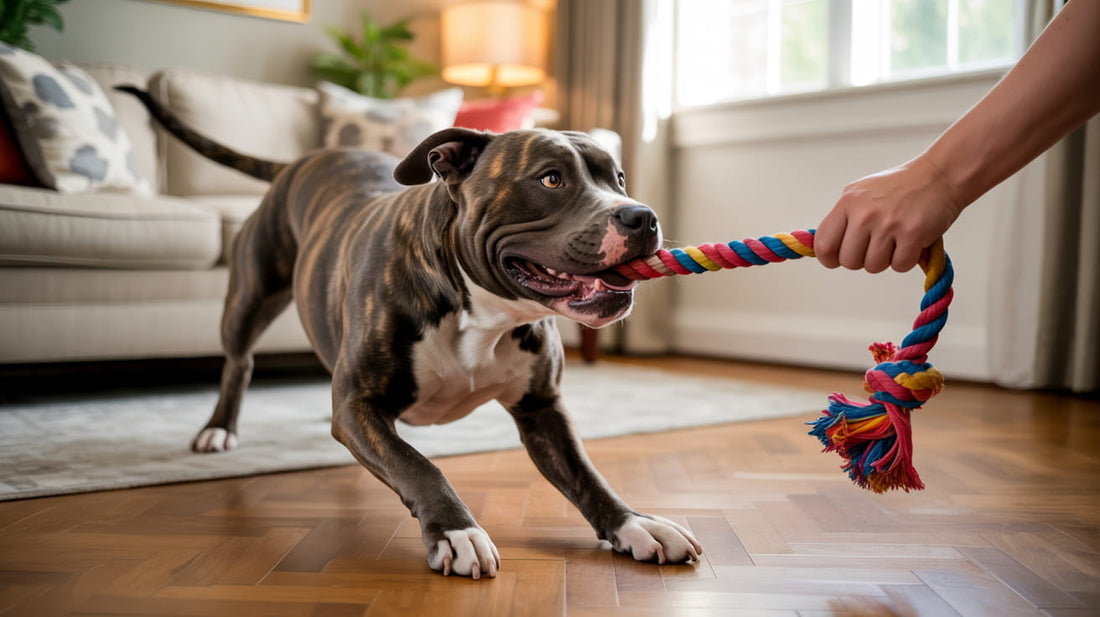Stuck inside with a restless dog? You can still build a strong workout routine that leaves your pup panting in a good way and snoozing afterward. With a few household items, a bit of structure, and upbeat energy, you can turn any living room or hallway into a fun, safe play zone.
You’ll cover five high-value activities that fit apartments and houses alike. Mix them across the day in short bursts, and you’ll see calmer behavior, better focus, and a dog that looks forward to play time with you.
Exercise 1: Tug-of-war with rules
Tug is fast, flexible, and wildly satisfying for many dogs. It builds muscle, raises heart rate, and gives your dog an acceptable outlet for that urge to grab and pull.
Try this:
- Pick a sturdy tug toy or braided rope. Retire any toy that frays or sheds strings.
- Teach a clear “take it” and “drop it.” Start easy: trade for a treat the moment your dog releases.
- Keep sessions short, about 1 to 3 minutes, then pause for a calm sit before a new round.
- Let your dog “win” sometimes, then cue “drop it” to restart the game.
Safety and success tips:
- Move the toy side to side near the ground, not up and down. That protects the neck and back.
- Keep teeth off skin rules. If teeth touch your hand, freeze the game for a few seconds, then resume.
- For puppies or small dogs, tug gently using soft toys. For large dogs, keep your stance grounded and knees soft.
You’ll notice improved impulse control when you insert obedience cues between rounds. Ask for a “sit” or “watch me,” reward, then say “take it.” This turns play into a training power-tool.
Exercise 2: Hallway fetch and stairs
Fetch works indoors with a simple tweak: use soft, low-bounce toys and a controlled space.
Here’s a clean setup:
- Choose a hallway or clear path. Move breakables and block side rooms with a baby gate.
- Throw a plush or foam ball a short distance. Keep tosses predictable to avoid sliding.
- If you have stairs with good traction, toss the toy up the steps for a few climbs. Supervise closely and keep the pace measured.
Turn it into a mini workout:
- 5 throws, rest. 5 throws, rest. Repeat for 3 to 4 sets.
- Ask for a “drop it” and a “sit” before each new toss to reel in over-arousal.
- For athletic dogs, the uphill climb builds cardio and hind-end strength. For seniors, skip the steps and stick to short, flat throws.
If your floors are slick, lay down runners or yoga mats for traction. Dogs struggle on shiny surfaces, and a few well-placed mats make a big difference.
Exercise 3: Flirt pole chase
A flirt pole is a pole or PVC wand with a cord and toy at the end. Think cat teaser, sized for dogs. It satisfies chase-and-pounce instincts without needing a long run.
Make it and play it:
- DIY a version with a sturdy stick, paracord, and a fleece toy. Or buy a purpose-made pole.
- Drag the toy quickly along the floor, zigzag around a small space, then let your dog catch it.
- Insert brief “wait” cues to work control, then release with “get it.”
Keep it smart:
- Cap sessions at 2 to 5 minutes with rest periods. This is a sprint, not a marathon.
- Avoid tight spins on slippery floors. Circle in wider arcs and use non-slip mats.
- Finish with a calm “down” and a treat scatter to lower arousal.
For dogs that love squirrels, this game is gold. You’re providing the chase in a safe, rules-based way.
Exercise 4: Living room obstacle course
Turn your home into a mini agility arena with pillows, chairs, boxes, and broom handles.
Build a simple course:
- Weave: line up dining chairs or pillows to create a slalom.
- Crawl: flatten a cardboard box into a tunnel top or drape a blanket over two chairs.
- Step-overs: lay broom handles or rolled towels for low rails.
- Target: place a mat or low cushion to hop onto and hold a “sit.”
Run it like a pro:
- Start with one obstacle, reward success, then add another.
- Keep jumps low and spacing wide. Aim for smooth, confident movement, not height.
- Walk the course together at first. Graduate to light jogging as your dog gains confidence.
- Use small treats or a favorite toy to guide and reward each element.
A course like this burns energy and sharpens body awareness. You can reconfigure it in minutes to keep it fresh.
Exercise 5: Scent games and puzzle feeding
Mental work can tire a dog faster than sprinting. Scent games tap into your dog’s strongest sense and deliver a deep, satisfying workout.
Start with easy wins:
- Cup game: hide a treat under one of three cups, shuffle slowly, and cue “find it.”
- Treat trail: place a short line of kibble leading to a hidden stash under a towel.
- Snuffle mat: scatter food into the fabric folds and let your dog search at their own pace.
Level it up:
- Hide-and-seek with you or a favorite toy. Ask for a “stay,” hide nearby, call, and throw a party when your dog finds you.
- Stuff a food-dispensing toy with kibble and a smear of peanut butter. Freeze it for added challenge.
- Build a scent hunt around a room. Start with one room, then open new zones as your dog gets the hang of it.
These activities take the edge off, reduce boredom, and provide a calm way to work in small spaces. They also help anxious dogs settle.
Quick-reference table
|
Exercise |
Best For |
Space Needed |
Gear |
Session Plan |
|---|---|---|---|---|
|
Tug-of-war |
Most dogs, high-energy breeds |
1 small play zone |
Sturdy tug toy |
3 to 5 rounds, 1 to 3 minutes each, include “drop it” |
|
Hallway fetch and stairs |
Young, athletic, or fetch-motivated dogs |
Hallway, optional stairs with traction |
Soft toy or plush ball |
3 to 4 sets of 5 throws with short rests |
|
Flirt pole |
Dogs with strong chase impulse |
Small to medium room with mats |
Flirt pole, DIY or store-bought |
2 to 5 minutes, 2 to 3 rounds, include “wait” and “get it” |
|
Obstacle course |
All sizes, tailor height |
Living room-sized |
Chairs, pillows, boxes, broom handles |
Build 3 to 6 obstacles, walk then jog, reward each success |
|
Scent and puzzle work |
All ages, great for seniors and shy dogs |
Any room |
Cups, towels, snuffle mat, puzzle toys |
5 to 15 minutes, raise difficulty over time |
Motivation that keeps your dog hooked
Your dog will work harder and focus longer when the payoff feels great.
Try these coaching tactics:
- Use high-value rewards. Mix bite-size treats, praise, and a short tug or fetch burst as bonuses.
- Keep it short and snappy. Several 5 to 10 minute sessions beat a long, tiring block.
- Rotate activities. Tug in the morning, scent work at lunch, fetch in the evening.
- Turn training into a game. Insert simple cues between reps and pay generously for quick responses.
- End on a win. Stop while your dog is happy and eager for more next time.
If your dog hesitates with new games, use a food trail to lure the first few reps. Confidence builds fast when wins are easy and consistent.
Safety first: set up a dog-ready space
A little prep prevents slips and mishaps.
- Clear the zone. Move vases, cords, pens, and small items off surfaces and floors.
- Add traction. Use rugs, yoga mats, or runners on slick floors where play happens.
- Gate off hazards. Close doors to stairs not in use and block rooms you don’t want your dog to dart into.
- Supervise stair play. Keep it slow and controlled. Skip stairs for tiny pups, seniors, and dogs with mobility concerns.
- Pick the right toys. Soft, durable, size-appropriate. Retire anything cracked or unraveling.
Think of it as a quick “pre-flight check.” Two minutes of setup buys you a stress-free session.
Tailor the plan to age and ability
You’ll get better results when you match intensity to your dog’s stage of life and health.
- Puppies
- Short, low-impact play. Gentle tug, brief fetch on flat surfaces, simple scent games.
- Frequent breaks, lots of naps, and plenty of potty trips.
- Keep jumps and stairs minimal. Focus on skills like sit, down, and recall during play.
- Adult dogs
- Mix cardio with brain work. Combine flirt pole or fetch with puzzle feeding and hide-and-seek.
- Use structured intervals. Work, rest, repeat.
- Progress difficulty gradually. More obstacles, tougher scent hides, longer “stay” before release.
- Senior dogs
- Prioritize scent work, slow indoor walks, and easy obstacle steps rather than jumps.
- Keep sessions gentle and add traction. Offer ramps or soft targets to step up on.
- Watch for signs of soreness. Short, frequent play beats one long session.
- Special considerations
- Overweight or arthritic dogs: focus on slow scent searches, short sets of low steps, and gentle tug. Ask your vet before starting anything new.
- Blind dogs: use sound-making or scented toys. Add light touch cues.
- Deaf dogs: rely on visual hand signals and clear body language.
Your dog’s enthusiasm is your best guide. If they show bright eyes, loose body, and quick recovery, you’re in the sweet spot. If you see lip licking, yawning, or avoidance, you’ve gone a bit too far or too fast.
A sample day that fits a busy schedule
You can layer play into your routine without carving out a huge block of time.
- Morning, 7 minutes: Snuffle mat breakfast or a cup game while coffee brews.
- Lunch break, 8 minutes: Obedience mini-circuit mixed with 3 tug rounds.
- After work, 12 minutes: Hallway fetch in sets or a flirt pole session with rests.
- Evening wind-down, 10 minutes: Hide-and-seek or a stuffed puzzle toy while you read.
That adds up to real exercise with very little friction. Your dog gets the variety they crave and you keep your day on track.
Make each of the five activities more challenging over time
Progress fuels engagement. Here’s a simple ramp-up plan for each exercise:
- Tug-of-war: Add a “stay” before “take it,” extend the duration of calm holds, introduce direction changes.
- Fetch: Increase distance slightly, add a “down” before release, or ask for a “wait” mid-hallway before the final retrieve.
- Flirt pole: Add pattern changes. Two quick zigzags, one pause, then release cue.
- Obstacle course: Add one new obstacle weekly, tighten turns, or require a 2-second “sit” on a target mat mid-course.
- Scent games: Move from visible to fully hidden treats, then expand to multiple rooms with a “find it” cue.
Keep notes on what works. A tiny training journal helps you spot patterns and keep variety high.
Troubleshooting common hiccups
- My dog gets too amped during tug or flirt pole
- Insert frequent breaks and a couple of easy cues, then reward calm before resuming.
- Lower intensity and end while your dog is still under threshold.
- My dog ignores puzzle toys
- Start with easy fillings and larger openings. Use part of your dog’s regular meal to build interest.
- Celebrate small wins and gradually increase difficulty.
- My dog slips on floors
- Add runners in a lane where play happens. Trim nails regularly and consider toe grips if needed.
- My senior loses interest halfway through
- Cut sessions in half and switch to gentle scent work. Use softer rewards and longer rest.
Pair indoor work with smart fueling and rest
Exercise and food go hand in hand. A few small treats during training are fine, but plan them into the daily calorie budget to manage weight. For food-dispensing toys, use your dog’s regular kibble and reserve higher-value fillers for tougher challenges.
Sleep is the other half. Expect a post-play nap. That rest period is when bodies rebuild and brains lock in new skills.
Why this approach pays off
Indoor activity covers more than steps on a fitness tracker. It trims fat, builds muscle tone, supports heart health, and keeps joints moving. The mental side matters just as much. Scent work, puzzle feeding, and hide-and-seek cut boredom and help anxious dogs settle. Older dogs stay sharper when you keep them active and engaged.
Most of all, you strengthen the bond with your dog. These games turn you into the source of all good things: fun, direction, and rewards.
A few square feet, a couple of household items, and your energy are enough to give your dog a great day. Start with one game from the list, keep it short and sweet, then build from there. Your dog will tell you how much they love it. And you’ll see the difference all over your home.


